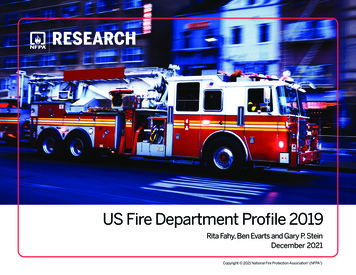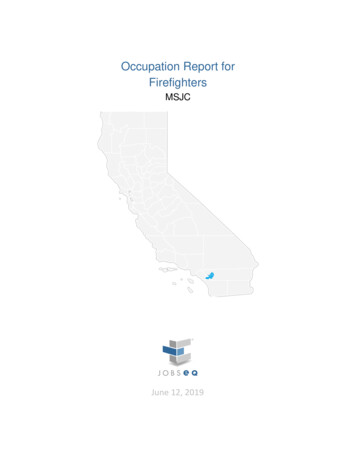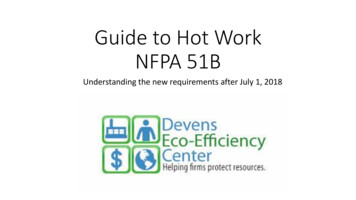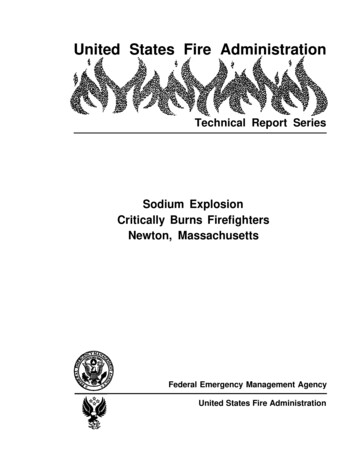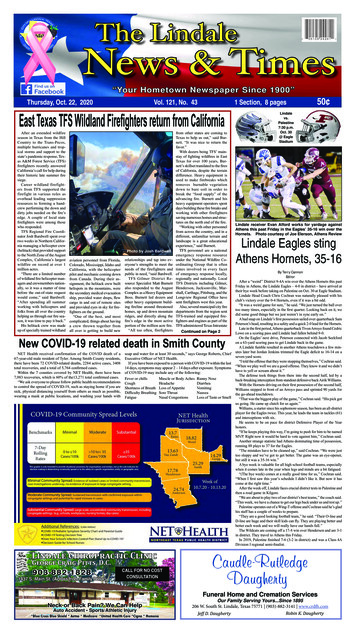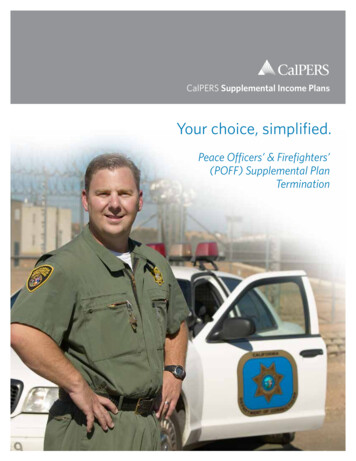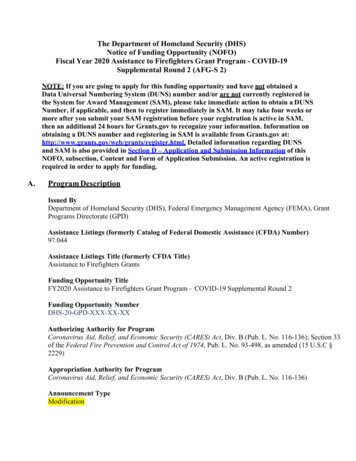
Transcription
The Department of Homeland Security (DHS)Notice of Funding Opportunity (NOFO)Fiscal Year 2020 Assistance to Firefighters Grant Program - COVID-19Supplemental Round 2 (AFG-S 2)NOTE: If you are going to apply for this funding opportunity and have not obtained aData Universal Numbering System (DUNS) number and/or are not currently registered inthe System for Award Management (SAM), please take immediate action to obtain a DUNSNumber, if applicable, and then to register immediately in SAM. It may take four weeks ormore after you submit your SAM registration before your registration is active in SAM,then an additional 24 hours for Grants.gov to recognize your information. Information onobtaining a DUNS number and registering in SAM is available from Grants.gov at:http://www.grants.gov/web/grants/register.html. Detailed information regarding DUNSand SAM is also provided in Section D – Application and Submission Information of thisNOFO, subsection, Content and Form of Application Submission. An active registration isrequired in order to apply for funding.A.Program DescriptionIssued ByDepartment of Homeland Security (DHS), Federal Emergency Management Agency (FEMA), GrantPrograms Directorate (GPD)Assistance Listings (formerly Catalog of Federal Domestic Assistance (CFDA) Number)97.044Assistance Listings Title (formerly CFDA Title)Assistance to Firefighters GrantsFunding Opportunity TitleFY2020 Assistance to Firefighters Grant Program – COVID-19 Supplemental Round 2Funding Opportunity NumberDHS-20-GPD-XXX-XX-XXAuthorizing Authority for ProgramCoronavirus Aid, Relief, and Economic Security (CARES) Act, Div. B (Pub. L. No. 116-136); Section 33of the Federal Fire Prevention and Control Act of 1974, Pub. L. No. 93-498, as amended (15 U.S.C §2229)Appropriation Authority for ProgramCoronavirus Aid, Relief, and Economic Security (CARES) Act, Div. B (Pub. L. No. 116-136)Announcement TypeModification
Program Overview, Objectives, and PrioritiesOverviewThe Fiscal Year (FY) 2020 Assistance to Firefighters Grant Program – COVID-19Supplemental Round 2 (AFG-S 2) is a supplemental funding opportunity under theAssistance to Firefighters Grant Program (AFG). AFG is one of three grant programs thatconstitute the Department of Homeland Security (DHS) Federal Emergency ManagementAgency’s (FEMA) focus on enhancing the safety of the public and firefighters with respectto fire and fire-related hazards.This is a modification of the original AFG-S NOFO published on April 24, 2020, FundingOpportunity Number DHS-20-GPD-044-00-99. In that original AFG-S NOFO, the initialapplication period, which was open to career, volunteer and combination fire departments;nonaffiliated emergency medical service (NAEMS) organizations; and state fire trainingacademies, closed on May 15, 2020. By law, at least 25 percent of available AFG-S fundsmust be awarded to volunteer fire departments and at least another 25 percent must beawarded to combination fire departments. Funding made available in this modified NOFOfor a second application period of AFG-S funding is limited to volunteer and combinationfire departments to fulfill this requirement. Volunteer and combination fire departments areeligible to apply in this round even if they had a successful application in the first round ofAFG-S funding; however, such applications must support new or additional needs orcapabilities. Departments that applied in the first round of AFG-S funding but wereunsuccessful can reapply to be considered for funding in this round; applications from thefirst round of AFG-S funding will not automatically carry forward to this round forconsideration. This NOFO allows eligible applicants to apply for critical Personal ProtectiveEquipment and supplies needed to prevent, prepare for and respond to the COVID-19 publichealth emergency. The AFG-S 2 Program represents part of a comprehensive set of measuresauthorized by Congress and implemented by DHS. Among the five basic homeland securitymissions noted in the DHS Quadrennial Homeland Security Review, the AFG-S 2 Programsupports the goal to Strengthen National Preparedness and Resilience. In awarding grants,the Administrator of FEMA is required to consider: The findings and recommendations of the Technical Evaluation Panel; The extent of an applicant’s need for an AFG-S 2 grant and the need to protectAmerica as a whole; and The number of calls requesting or requiring a firefighting or emergency medicalresponse received by an applicant.The 2018-2022 FEMA Strategic Plan creates a shared vision for the field of emergency management andsets an ambitious, yet achievable, path forward to unify and further professionalize emergencymanagement nationwide. The AFG-S 2 Program supports the goal of Readying the Nation forCatastrophic Disasters. We invite all of our stakeholders and partners to also adopt these priorities andjoin us in building a stronger agency and a more prepared and resilient Nation.
ObjectivesThe objectives of the AFG-S 2 program are to provide critically needed resources that equip personnelto respond to the COVID-19 public health emergency and support community resilience.PrioritiesInformation on program priorities and objectives for the FY 2020 AFG-S 2 can be found in Appendix A Programmatic Information and Priorities.Performance MetricsPerformance metrics for this program are as follows:Percentage of AFG-S 2 recipients who equipped 100 percent of on-duty active members with PersonalProtective Equipment (PPE) in compliance with applicable National Fire Protection Association andOccupational Safety and Health Administration standards.B.Federal Award InformationAvailable Funding for the NOFO: 31 millionProjected number of Awards:500Period of Performance:Twelve months from the date of award. Foradditional information on period of performanceextensions, refer to Section H.Projected Period of Performance Start Date(s):Jan. 15, 2021Projected Period of Performance End Date(s):Jan. 14, 2022Funding Instrument: GrantC.Eligibility InformationEligible Applicants Volunteer Fire DepartmentsCombination Fire DepartmentsApplicant Eligibility CriteriaVolunteer and Combination Fire Departments: Volunteer and Combination fire departmentsoperating in any of the 50 states, as well as fire departments in the District of Columbia, the
Commonwealth of the Northern Mariana Islands, the U.S. Virgin Islands, Guam, American Samoa, theCommonwealth of Puerto Rico or any federally recognized Indian tribe or tribal organization. A firedepartment is an agency or organization having a formally recognized arrangement with a state, local,tribal or territorial authority (city, county, parish, fire district, township, town or other governing body)to provide fire suppression to a population within a geographically fixed primary first due responsearea.Combination Fire Department, as defined in 15 U.S.C. § 2229, means a fire department that has paidfirefighting personnel and volunteer firefighting personnel. Departments that pay fees or stipends tofirefighting personnel for each event to which they respond (paid on call) are also considered under thiscategory.Volunteer Fire Department, as defined in 15 U.S.C. § 2229, means a fire department that has an allvolunteer force of firefighting personnel.Eligible ActivitiesActivities under this solicitation are limited to the purchase of PPE and supplies to prevent, preparefor, and respond to the COVID-19 public health emergency. This includes reimbursement forexpenditures made since January 1, 2020.Other Eligibility CriteriaNational Fire Incident Reporting System (NFIRS)NFIRS reporting is not a requirement to apply for the AFG-S 2 Program. However, fire departmentsthat receive funding under this program must agree to provide information to the NFIRS for the periodcovered by the assistance. If a recipient does not currently participate in the incident reporting systemand does not have the capacity to report at the time of the award, that recipient must agree to provideinformation to the system for a 12-month period commencing as soon as possible after they developthe capacity to report.Capacity to report to the NFIRS must be established prior to the termination of the one-yearperformance period. The recipient may be asked by FEMA to provide proof of compliance in reportingto NFIRS. Any recipient that stops reporting to NFIRS during their grant’s period of performance maybe subject to the remedies for noncompliance in 2 C.F.R. Part 200, unless it has yet to develop thecapacity to report to NFIRS, as described above.Note: Although data collection is an important tool for understanding and justifyingassistance, participation in other data sources, (e.g., National Fire Operations ReportingSystem [NFORS]) does not satisfy the requirement for reporting to NFIRS.National Incident Management System (NIMS) ImplementationAFG-S 2 applicants are not required to be in compliance with NIMS to apply for AFG-S 2 funding orto receive an AFG-S 2 award. Any applicant who receives an FY2020 AFG-S 2 award must achievethe level of NIMS compliance required by the Authority Having Jurisdiction over the applicant’semergency service operations (e.g., a local government), prior to the end of the grant’s period ofperformance.
Maintenance of EffortPursuant to 15 U.S.C. § 2229(k)(3), an applicant seeking an AFG-S 2 grant shall agree tomaintain, during the term of the grant, the applicant’s aggregate expenditures relating toactivities allowable under this NOFO and the FY 2019 AFG NOFO, at not less than 80percent of the average amount of such expenditures in the two fiscal years prior to the fiscalyear an AFG-S 2 grant is awarded.In other words, an applicant agrees, if it receives a grant award, to keep its overallexpenditures during the award’s period of performance (including those funded with nonFederal funding) for activities that could be allowable costs under this AFG-S 2 NOFO andthe FY 2019 AFG NOFO at a level that is at least 80 percent or more of the average of whatthe applicant spent on such costs for those activities in fiscal years 2018 and 2019.Cost Share or MatchIn general, eligible applicants shall agree to make available non-federal funds to carry out anAFG-S 2 award in an amount equal to and not less than 15 percent of the grant awarded.Exceptions to this general requirement apply to entities serving smaller communities asfollows: When serving a jurisdiction of 20,000 residents or fewer, the applicant shall agree tomake available non-federal funds in an amount equal to and not less than 5 percent ofthe grant awarded; and/or When serving a jurisdiction of more than 20,000 residents, but not more than 1 millionresidents, the applicant shall agree to make available non-federal funds in an amountequal to and not less than 10 percent of the grant awarded.FEMA has developed a cost share calculator tool in order to assist applicants with determining theircost share. The cost share tool is available at: ntal-afg-s.Types of Cost Sharei.Cash (Hard Match): Cost share of non-federal cash is the only allowable recipientcontribution for AFG-S 2 activity.ii.Trade-In Allowance/Credit: On a case-by-case basis, FEMA may allow recipients alreadyowning assets acquired with non-federal cash to use the trade-in allowance/credit value ofthose assets as cash for the purpose of meeting their cost share obligation. For FEMA toconsider a trade-in allowance/credit value as cash, the allowance amount must bereasonable, and the allowance amount must be a separate entry clearly identified in theacquisition documents.
iii.In-kind (Soft Match): In-kind cost share is not allowable for AFG-S 2.The award budget will not account for any voluntary committed cost sharing or overmatch.The use of an overmatch is not given additional consideration when scoring applications.Economic Hardship WaiversThe Administrator of FEMA may waive or reduce recipient cost share or maintenance of effortrequirements in cases of demonstrated economic hardship. Please see Appendix B: AwardAdministration Information for additional information.D.Application and Submission InformationKey Dates and TimesApplication Start Date:Application Submission Deadline:Anticipated Funding Selection Date:Anticipated Award Date:Oct. 6, 2020 at 8 a.m. ETNov. 13, 2020 at 5 p.m. ETJan. 15, 2021Jan. 15, 2021In general, DHS/FEMA will not consider for funding applications received after the deadline.DHS/FEMA may, however, extend the application deadline on request for any applicant who candemonstrate that good cause exists to justify extending the deadline. Good cause for an extension mayinclude technical problems outside of the applicant’s control that prevent submission of the applicationby the deadline, or other exigent or emergency circumstances. If applicants experience technical issues,they must notify the AFG Help Desk as soon as possible. The AFG Help Desk can be reached at 1-866274-0960 or by e-mail: firegrants@fema.dhs.gov. The AFG Help Desk is open Monday – Friday, 8 a.m.– 4:30 p.m. ET.Other Key DatesEventSuggested Deadline for CompletionRegister Organization in FEMA GOPrior to beginning applicationSubmitting complete application in FEMA GOOne week before actual submission deadlineAgreeing to Terms and Conditions of the AwardBy submitting an application, the applicant agrees to comply with the requirements of this NOFO and theterms and conditions of its award, should the applicant receive an award.Address to Request Application PackageThe online FY 2020 AFG-S 2 application is only available via the AFG Program’s FEMA GO(FEMA Grants Outcomes) application portal, at https://go.fema.gov.
Note: Hard copies of the application are not available. However, the Telephone Device for the Deaf(TDD) and/or Federal Information Relay Service (FIRS) number available for this Notice is (800) 4627585.Steps Required to Submit an Application.DHS makes all funding opportunities available on the internet, accessible at http://www.grants.gov. Ifapplicants experience difficulties accessing information or have any questions, please call the Grants.govContact Center at (800) 518-4726.The Grants.gov website will direct applicants to FEMA GO, at https://go.fema.gov, which contains theonline AFG-S 2 application. The online AFG-S 2 application incorporates all required forms.FEMA GO will allow the applicant’s authorized representative(s) to log in and create their own account.This account is specific to the authorized user and must not be shared with other personnel. The FEMAGO account is separate from any previous accounts created in the eGrants system. Applicants can save,retrieve, update and revise their work through the end of the application period. The automated systemdoes not allow applicants to submit incomplete applications. The system alerts applicants when requiredinformation has not been entered. Prior to final submission, an online application may be saved,retrieved, or edited up to the application deadline.Note: FEMA GO is compatible with Internet Explorer (version 11 or higher), Microsoft Edge (version 85or higher), Firefox (version 63 or higher), or Chrome (version 70 or higher). Users who attempt to usetablet type devices or other browsers may encounter issues with using FEMA GO.There is no appeal process for inaccurate or incomplete information retained by the system due toimproper or multiple browser usage by applicants.Electronic DeliveryDHS is participating in the Grants.gov initiative that provides the grant communities a single site to findgrant funding opportunities. Before applying for a DHS Grant, applicants must have a Data UniversalNumber System, or DUNS number, and must be registered and active in SAM.DUNS NumberAll entities applying for funding, including renewal funding, must have a Data Universal NumberingSystem (DUNS) number from Dun & Bradstreet (D&B). Applicants must enter the DUNS number in thedata entry field labeled "Organizational DUNS" on the SF-424 form. Instructions for obtaining a DUNSnumber can be found at the following s/organization- registration/step-1-obtain-duns- number.html.System for Award Management (SAM)Applicant registration in SAM is free. All applicants must be registered and active in order to applyonline. Step-by-step instructions for registering with SAM can be found here: SAM Registration HomePage. Please remember that SAM registration is only active for one year and must be renewed annually.
Existing SAM.gov account holders should check their account to make sure it is “ACTIVE.” SAMregistration should be completed at the very beginning of the application period and renewed annually toavoid becoming "INACTIVE."Please allow plenty of time before the grant application submission deadline to obtain a DUNSnumber and then to register in SAM. It may take four weeks or more after the applicant submits theSAM registration before the registration is active in SAM, then an additional 24 hours for Grants.govto recognize the information.Applicants are advised that FEMA may not make a federal award until the applicant has complied with allapplicable DUNS and SAM requirements. Therefore, an applicant’s SAM registration must be active notonly at the time of application, but also during the application review period and when FEMA is ready tomake a federal award. Further, applicants must maintain an active SAM registration with currentinformation at all times during which the applicant has an active federal award or an application or planunder consideration by any federal awarding agency. If an applicant’s SAM registration is expired at thetime of application, expires during application review, or expires any other time before award, FEMA maydetermine that the applicant is not qualified to receive a federal award and use that determination as a basisfor making a federal award to another applicant.As part of the SAM registration process, applicants must now provide information in SAM on theirimmediate owner and highest-level owner and subsidiaries, as well as on all predecessors that have beenawarded a federal contract or federal financial assistance within the last three years. This is a newrequirement instituted by amendments to 2 C.F.R. part 25 made by the Office of Management and Budgeton Aug. 13, 2020.Per 2 C.F.R. § 25.110(c)(2)(ii), if an applicant is experiencing exigent circumstances that prevents it fromreceiving a DUNS number and completing SAM registration prior to receiving a federal award, theapplicant must notify FEMA as soon as possible and provide the details of the exigent circumstances thatprevent completion of these requirements. If FEMA determines that there are exigent circumstances andFEMA has decided to make an award, the applicant will be required to obtain a DUNS number andcomplete SAM registration within 30 days of the federal award date.IMPORTANT: The SAM registration process must be completed by the applicant. It is imperative thatthe information provided by the applicant is correct and current. Please ensure that your organization’sname, address, DUNS number and Employer Identification Number, or EIN, are up to date in SAM andthat the DUNS number used in SAM is the same one used to apply for all other FEMA awards. Theorganization’s name on the SF 1199A Direct Deposit Form must be entered as it appears in SAM.Payment under any FEMA award is contingent on the recipient’s having a current SAM registration.Help with SAMThe SAM quick start guide for new recipient registration and SAM video tutorial for new applicants aretools created by the General Services Administration (GSA) to assist those registering with SAM. Ifapplicants have questions or concerns about a SAM registration, please contact the Federal Support Deskat https://www.fsd.gov/fsd- gov/home.do or call tollfree (866) 606-8220.
How to Get a Commercial and Government Entity (CAGE) CodeTo get a CAGE code, applicants must first be registered in SAM, which is a requirement for doingbusiness with the Federal Government. Applicants will be assigned a CAGE code as part of the SAMvalidation process, and as soon as the registration is active, applicants may view the CAGE code onlineby logging in to the SAM account.Timely Receipt Requirements and Proof of Timely SubmissionAll applications must be received by Nov. 13, 2020 at 5 p.m. ET. FEMA GO automatically recordsproof of timely submission and the system generates an electronic date/time stamp when FEMA GOsuccessfully receives the application. The individual with the Authorized Organization Representative(AOR) role that submitted the application will also receive the official date/time stamp and a FEMA GOtracking number in an email serving as proof of their timely submission on the date and time that FEMAGO received the application. Applications received by FEMA GO after the established due date forapplications will be considered late and will not be considered for funding.Applicants using slow internet connections, such as dial-up connections, should be aware thattransmission can take some time before FEMA GO receives your application. FEMA GO will provideeither an error message or a successfully received transmission in the form of an email sent to the AORthat submitted the application. The FEMA GO Support Center reports that some applicants end thetransmission because they think that nothing is occurring during the transmission process. Do not dothis; it may cause your application to fail to be submitted and consequently not be considered forfunding. Please be patient and give the system time to process the application.Intergovernmental ReviewAn intergovernmental review may be required. Applicants must contact their state’s Single Point ofContact (SPOC) to comply with the state’s process under Executive Order 12372 fication/executive- tent/uploads/2019/02/SPOC- February-2019.pdf).Funding RestrictionsFederal funds made available through this award may only be used for the purposes set forth in thisaward and must be consistent with the statutory authority for the award. Award funds may not be usedfor matching funds for any other federal grants/cooperative agreements, lobbying, or intervention infederal regulatory or adjudicatory proceedings. In addition, federal funds may not be used to sue theFederal Government or any other government entity. Failure to adhere to the award conditions will causethe recipient to be considered in default of the grant agreement and may require the return of all federalfunds disbursed under the grant.Federal employees are prohibited from serving in any capacity (paid or unpaid) on the development ofany proposal submitted under this program.Allowable CostsPre-award CostsPre-award expenditures for eligible PPE and supplies are eligible under this program. The expendituresmust have been made after Jan. 1, 2020. Fees for grant writers are also included as a pre-awardexpenditure.
Fire DepartmentsThe total amount of funding a fire department recipient may receive under an AFG-S award (defined forthese purposes as the sum total of any awards under the initial AFG-S and this AFG-S 2) is limited tomaximum amounts set by §33(c)(2) of the Federal Fire Prevention and Control Act of 1974, as amended(15 U.S.C. § 2229(c)(2)). These award limits are based on two factors: population served and a onepercent aggregate amount of available grant funds.The population of the jurisdiction served by the recipient will determine the maximum amount of AFG-S2 funding a recipient is eligible to receive but no recipient may receive an award (when considering anyinitial AFG-S award plus an award under AFG-S 2) that exceeds one (1) percent of available grant fundsfor the entire FY 2020 AFG-S, or 1,000,000. FEMA may waive this aggregate cap of 1 million inindividual cases where FEMA determines that a recipient has an extraordinary need for a grant thatexceeds the aggregate cap. FEMA may not waive the statutory funding caps based on population size.The following table explains the maximum funding that a recipient may receive under this solicitation:Population of JurisdictionServed by the RecipientMaximum Award inFY 2020 (AFG-S 2)Statutory Waiver AvailableSubject to Extraordinary Need?100,000 or fewer people100,001 – 500,000 peopleNo more than 1 millionNo more than 1 millionNone availableYes, but no more than 2 million500,001 – 1,000,000 peopleNo more than 1 millionYes, but no more than 3 million1,000,001 – 2,500,000 peopleNo more than 1 millionYes, but no more than 6 millionMore than 2,500,000 peopleNo more than 1 millionYes, but no more than 9 millionThe cost share for a Regional application will apply the requirements above based on the aggregatepopulation of the primary first due response areas of the host and participating partner organizations thatexecute a Memorandum of Understanding (MOU).Allocations and Restrictions of Available Grant Funds by Organization Type Micro Grants: The selection of the voluntary Micro Grant option (cumulativefederal funding of 3,000) for eligible activities does not impact an applicant’srequest or federal participation under Regional projects. Applicants who select MicroGrants as a funding opportunity choice may still apply for a Regional project.Further, at least 150,000 of the available funds will be allocated toward thisapplicant type. Regional Projects: A Regional application is an opportunity for a volunteer orcombination Fire Department to act as a host and apply for funding on behalf ofitself and any number of other participating AFG eligible organizations. FireDepartments that serve as host regional applicants can apply on behalf of othereligible fire departments within the same application. Career fire departments arenot eligible to apply under the Regional activity or be included in a regional award.Regional activities should achieve cost effectiveness, support regional efficiency and
resilience, and benefit more than one local jurisdiction (county, parish, town,township, city, or village) directly from the activities implemented with the grantfunds.The community identification characteristic (e.g., rural, urban, or suburban) and theorganizational status of the host applicant (e.g., combination or volunteer) will be entered andused for the regional application, regardless of the composition of the participating partners.In the application narrative, a Regional host must include a list of all the AFG-S 2 eligibleparticipating organizations benefitting from a proposed Regional project, including validatedpoints of contact, each organization’s Employee Identification Number (EIN), and clear anddetailed information on the regional activities requested.Host organizations should provide specific details, fully explaining the distribution of any grantfunded acquisitions or grant-funded contracted services, as well as the responsibilities betweenthe host and the partner organizations.The host will be required to enter information that captures the macro demographics (e.g., totalsquare miles) and master listings of information (e.g., combined supply inventories) of thepartners that serve the region.All participants of a Regional applicant must be compliant with AFG requirements, includingbeing current with past grants, closeouts, and other reporting requirements. Upon notificationby the AFG Program Office, the host agency shall not distribute grant funded assets or providegrant-funded contractual services to non-compliant partner organizations. The host and thedelinquent partners will be notified by the AFG Program Office of their specific deficiency.Regional host applicants and participating partner agencies must execute a Memorandum ofUnderstanding (MOU) or equivalent document signed by the host and all participatingorganizations. The agreement should specify the individual and mutual responsibilities of theparticipating partners, the participant’s level of involvement in the project(s), and the proposeddistribution of all grant funded assets and/or contracted services. Copies of the MOU will berequested during the technical evaluation of the application.The MOU must specify the individual and mutual responsibilities of the host andparticipating partners, the host’s and participant’s level of involvement in the project(s), theparticipating partner’s EIN numbers, and the proposed distribution of all grant funded assetsor contracted services. Any entity named in the application as benefiting from the award mustbe an eligible AFG organization and must be a party to the MOU or equivalent document.Regional applicants will be subject to the funding limitations based on the total populationserved by the host and participating partners. Additionally, Regional grants awarded areincluded in the host organization’s funding limitations. For example: if a recipient serves apopulation of 100,000 or fewer and is the recipient of a Regional award for 1 million, theyhave met their cap and are no longer eligible for additional funds through this solicitation.Management and Administration (M&A) Costs: Expenses should be based only on actualexpenses or known contractual costs; requests that are simple percentages of the award, withoutsupporting justification, will not be allowed or considered for reimbursement. No more than 3percent of the federal share of AFG-S 2 funds awarded may be expended by the recipient formanagement and administration (M&A) for purposes associated with the AFG-S 2 award.Indirect Facilities & Administrative (F&A) Costs: Indirect costs are allowable under this
program as described in 2 C.F.R. pt. 200, including 2 C.F.R. § 200.414. Applicants with anegotiated indirect cost rate agreement that desire to charge indirect costs to an award mu
Assistance Listings (formerly Catalog of Federal Domestic Assistance (CFDA) Number) 97.044 . Assistance Listings Title (formerly CFDA Title) Assistance to Firefighters Grants . Funding Opportunity Title . FY2020 Assistance to Firefighters Grant Program - COVID-19 Supplemental Round 2 . Funding Opportunity Number . DHS-20-GPD-XXX-XX-XX
